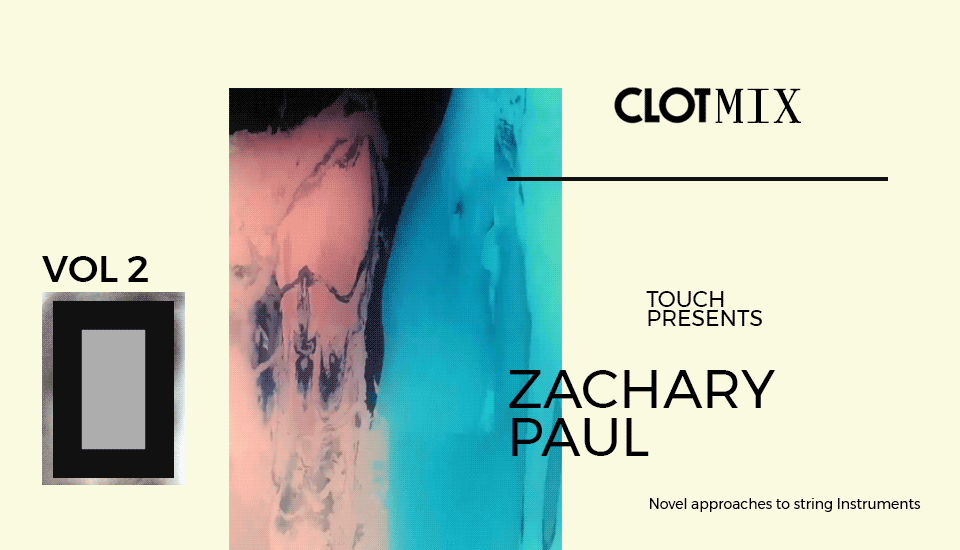Text by CLOT Magazine

For our 2nd mixtape, experimental musician Zachary Paul has prepared a selection of novel approaches to string instruments. Zachary Paul is a violinist and composer interested in perception, the transportive nature of long durations, and trance states.
His work explores the contrast between stasis and movement and questions the possibility of depicting both synchronously with a profound sensibility and emotion, drawing from a long lineage of artists exploring sustained tones within organic performance, including Tony Conrad, Pauline Oliveros, and La Monte Young.
Zachary is currently a participant in Touch’s curated mentorship program, where he also released his first album A Meditation on Discord, last April 2019. He also had some time to share a few words with us.
You are a violinist and composer, and for this mix, you’ve prepared a selection with Novel Approaches to String Instruments. In what way does your practice explore novel approaches to string-based instruments?
Growing up as a classical musician, I was always attracted to composers who invited the performer to play their instruments in a unique way. The vocabulary of the violin is much larger than the twelve diatonic scale notes. There is something inherently rebellious about searching for the sounds I was instructed to avoid as a young musician.
I am particularly interested in micro-tonality. This interest stems from my study of Balinese gamelan in college, in which every instrument is paired with an identical instrument detuned just slightly enough to create shimmery beats in the air when both play the same note. I create these physical shimmers in my work via microtonally detuning notes as I layer them on each other. You can hear this effect particularly clearly on “Premonition.”
Additionally, I am constantly exploring the textural effects possible with the violin, pitched and unpitched. While I didn’t include it in the mix, Penderecki’s “Threnody for the Victims of Hiroshima” is a master class in the sorts of textural sounds one can conjure from a string instrument and a highly recommended listen. This piece, along by works by Bartok, Ligeti, & Xenakis, introduced me to a unique vocabulary for the violin, which I constantly pull from an attempt to build upon in nearly every performance. Because I work with loop pedals, I can replicate many of these composers’ sounds without the need for a full ensemble.
You just published an album in Touch, A Meditation on Discord, with recordings of different live performances and a score for a short film. What’s the common element that brings these tracks together?
In a recent chat with Dustin Wong on Dublab, we thought of my music (and much of the minimalism and drone from which it is inspired) as “creating a canvass,” rather than painting onto a canvass. In other words, while most music aims to depict an idea or set of the artist’s choice, I am interested in giving the listener the agency to interact with my music on their own terms. While my program notes delineate what energies inspired me to make these sounds, my compositions are so vast & minimal that the listener can take away many interpretations.
At the very least, I am creating the “world” within which the listener can participate, for example either focusing in on my present performance and each layer as it is added, taking in the whole mass of the sound, or tuning into a previously added layer and tracking its progress.
“A Person With Feelings” is the most distinct of the three pieces, as a trifurcated studio recording rather than a continuous live performance. With this piece, I am most concerned with showcasing the textural range of the violin, utilizing many of the extended techniques I discussed above. Yet, my compositional philosophy still stands. While the first two pieces are singularly focused, I see the three sections of “A Person With Feelings” as three separate worlds, extremely compressed yet still vast enough for the listener to move around in.
What is your relationship with novel musical technology nowadays? What use do you make of it for your compositions?
My performance set-up is very modest, and I often avoid relying too much on musical technology. I’ve never been able to wrap my head around MaxMSP (although hopefully someday!), and I recently got a Hologram Electronics Infinite Jets pedal, which I’ve barely used due to the overwhelming number of possibilities it has opened! With my minimal set-up of loop, reverb, and delay pedals, I can feel fully in control of shaping the sound I am producing without fear of technology taking over and moving the composition elsewhere.
However, my fear of electronic technology pushes me to devise increasingly creative ways to utilize the instrument itself. The more I play the violin, the more I fall in love with it. I often spend long periods staring at the instrument, studying its design, material, and colour. The technology I use only bolsters what is already one of the greatest pieces of music technology ever created.






